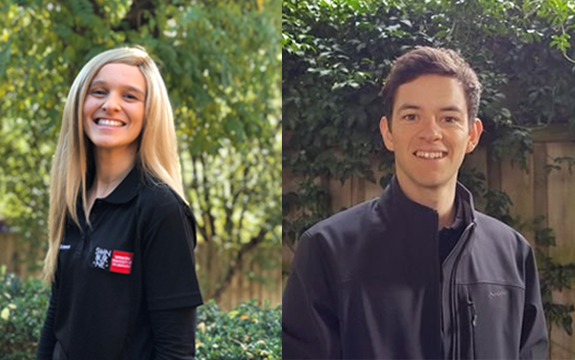Getting creative with at-home exercise routines during isolation

In Summary
- Our Bachelor of Exercise and Sport Science students have been getting creative with their exercise routines during isolation
- These routines use objects available at home, such as milk containers and a skateboard
- This cohort of students have transitioned to a telehealth exercise placement
A group of our Bachelor of Exercise and Sport Science students have come up with at-home exercise routines using equipment that most of us have lying around the house, such as skateboards and milk containers. They are among a cohort of third-year students who have transitioned to a telehealth exercise placement that will help their studies progress without delay.
No equipment, no problem
Third-year student, Jessica Toone came up with at-home exercise routines to help people who may be struggling to exercise while practicing physical distancing.
“I had been thinking about how people might be exercising during isolation as many people won’t have access to specific gym equipment to perform their normal routines. This could cause some to avoid exercising all together and for others, frustration and anxiety,” she explains.
Ms Toone adds, “I thought about what objects could be adapted to replace normal gym equipment and came up with the idea of using milk containers. This is something that many people would have, and the weight can be varied depending on fitness levels.”
Ms Toone says milk containers are a great exercise tool as they can be customised to fit different fitness levels
Fellow third-year student, Jacob Simpson experimented with his skateboard and came up with several exercise routines. “I was searching for something to use for my hamstring curls and came across my skateboard. While I was at it, I decided to test out what else I could use it for and came up with a number of different routines,” he explains.
Mr Simpson uses his skateboard to create different exercise routines
Course director of the Bachelor of Exercise and Sport Science program, Associate Professor Amanda Benson applauds these students for their creativity. “It has been fantastic to see students like Jacob and Jess embrace the challenge of developing digital content for their professional portfolios during this semester,” she says.
“It's always rewarding seeing students put their skills together and start sharing them with the industry,” Associate Professor Benson adds.
Helping our students progress with their learning
Mr Simpson and Ms Toone are among a cohort of third year Bachelor of Exercise and Sport Science program students who have transitioned to a telehealth exercise placement. These students commenced their placements at the beginning of the year, but these were halted due to the coronavirus (COVID-19) restrictions.
The telehealth placement program, which will run for five weeks includes a combination of simulated experiences and remote exercise prescription to actual clients. “The telehealth placements will enable our students to continue with their degree without delays and develop work-ready skills that the industry has also rapidly embraced in response to the COVID-19 restrictions,” says Associate Professor Benson.
She adds, “The way our students have adjusted to a telehealth placement should be commended. I am sure it will help them refine their communication, problem solving and exercise prescription skills, all of which are valuable for working in our industry.”
Meanwhile, both Mr Simpson and Ms Toon have embraced this new way of learning.
“While there are some challenges in transitioning to a telehealth placement, like trying to form relationships with new clients and prescribing exercises, I think it has been a great opportunity to learn a completely new skill and I think that these types of placements will become more prominent in the future,” says Mr Simpson.
Ms Toone echoes this sentiment, “At first it was a bit daunting moving to a telehealth platform. I wasn’t sure how it was going to work and if I would be able to deal with it. However, I have found that it has been good to be able to continue with my placement during the isolation period.”
She adds, “I can see how telehealth would have benefits in this profession, for instance if a client was unable to attend a physical appointment, they would still be able continue with their consultations.”

